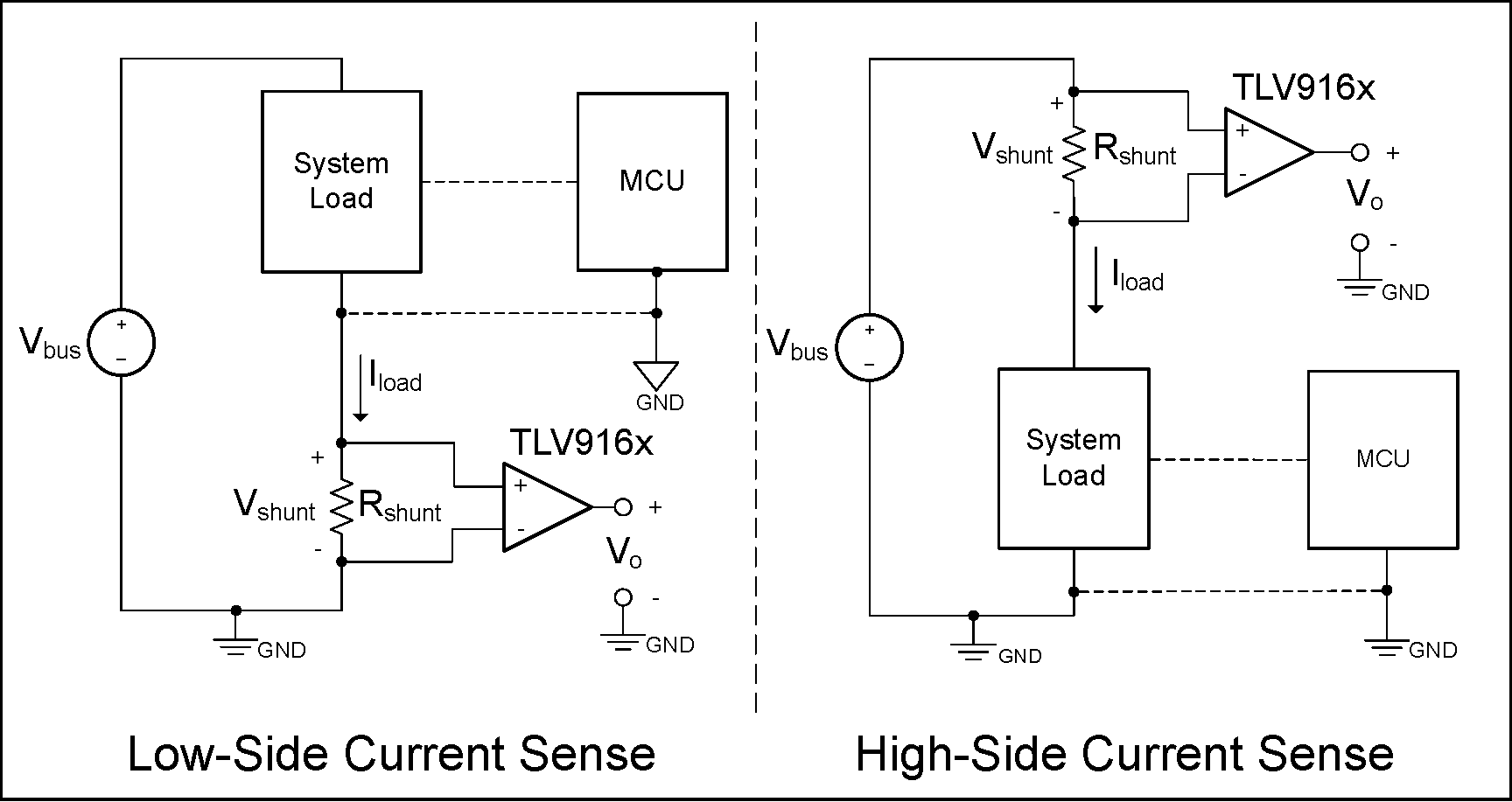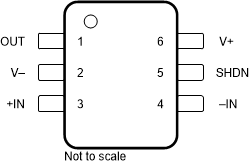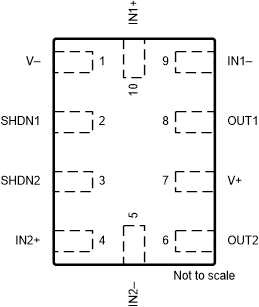-
TLV916x 16V, 11MHz, Rail-to-Rail Input/Output, Low Offset Voltage, Low Noise Op Amp
- 1
- 1 Features
- 2 Applications
- 3 Description
- 4 Pin Configuration and Functions
- 5 Specifications
-
6 Detailed Description
- 6.1 Overview
- 6.2 Functional Block Diagram
- 6.3
Feature Description
- 6.3.1 Input Protection Circuitry
- 6.3.2 EMI Rejection
- 6.3.3 Thermal Protection
- 6.3.4 Capacitive Load and Stability
- 6.3.5 Common-Mode Voltage Range
- 6.3.6 Phase Reversal Protection
- 6.3.7 Electrical Overstress
- 6.3.8 Overload Recovery
- 6.3.9 Typical Specifications and Distributions
- 6.3.10 Packages With an Exposed Thermal Pad
- 6.3.11 Shutdown
- 6.4 Device Functional Modes
- 7 Application and Implementation
- 8 Device and Documentation Support
- 9 Revision History
- 10Mechanical, Packaging, and Orderable Information
- IMPORTANT NOTICE
Package Options
Mechanical Data (Package|Pins)
Thermal pad, mechanical data (Package|Pins)
Orderable Information
Data Sheet
TLV916x 16V, 11MHz, Rail-to-Rail Input/Output, Low Offset Voltage,
Low Noise Op Amp
1 Features
- Low offset voltage: ±210µV
- Low offset voltage drift: ±0.25µV/°C
- Low noise: 6.8nV/√Hz at 1kHz, 4.2nV/√Hz broadband
- High common-mode rejection: 110dB
- Low bias current: ±10pA
- Rail-to-rail input and output
- MUX-friendly/comparator inputs
- Amplifier operates with differential inputs up to supply rails
- Amplifier can be used in open-loop or as comparator
- Wide bandwidth: 11MHz GBW, unity-gain stable
- High slew rate: 33V/µs
- Low quiescent current: 2.4mA per amplifier
- Wide supply: ±1.35V to ±8V, 2.7V to 16V
- Robust EMIRR performance
3 Description
The TLV916x family (TLV9161, TLV9162, and TLV9164) is a family of 16V, general-purpose operational amplifiers. These devices offer exceptional DC precision and AC performance, including rail-to-rail input/output, low offset (±210µV, typical), low-offset drift (±0.25µV/°C, typ), and low noise (6.8nV/√Hz at 1kHz, 4.2nV/√Hz at 10kHz).
Features such as differential and common-mode input voltage ranges to the supply rails, high short-circuit current (±73mA), and high slew rate (33V/µs) make the TLV916x a flexible, robust, and high-performance op amp for industrial applications.
The TLV916x family of op amps is available in small-size packages (such as X2QFN and WSON), as well as standard packages (such as SOT-23, SOIC, and TSSOP), and is specified from –40°C to 125°C.Device
Information
| PART NUMBER(1) | CHANNEL COUNT | PACKAGE | PACKAGE SIZE(2) |
|---|---|---|---|
| TLV9161 | Single | DCK (SC70, 5) | 2.00mm × 2.10mm |
| DBV (SOT-23, 5) | 2.90mm × 2.80mm | ||
| TLV9161S | Single, Shutdown | DBV (SOT-23, 6) | 2.90mm × 2.80mm |
| TLV9162 | Dual | D (SOIC, 8) | 4.90mm × 6.00mm |
| DDF (SOT-23, 8) | 2.90mm × 2.80mm | ||
| PW (TSSOP, 8) | 3.00mm × 6.40mm | ||
| DGK (VSSOP, 8) | 3.00mm × 4.90mm | ||
| DSG (WSON, 8) | 2.00mm × 2.00mm | ||
| TLV9162S | Dual, Shutdown | RUG (X2QFN, 10) | 1.50mm × 2.00mm |
| TLV9164 | Quad | D (SOIC, 14) | 8.65mm × 6.00mm |
| PW (TSSOP, 14) | 5.00mm × 6.40mm |
(1) For more information, see Section 10
(2) The package size (length × width) is a nominal value and includes pins, where
applicable.
 TLV916x
in Current-Sensing Applications
TLV916x
in Current-Sensing Applications4 Pin Configuration and Functions
 Figure 4-1 TLV9161
DBV Package
Figure 4-1 TLV9161
DBV Package5-Pin SOT-23
(Top View)
 Figure 4-2 TLV9161
DCK Package
Figure 4-2 TLV9161
DCK Package5-Pin SC70
(Top View)
Table 4-1 Pin Functions: TLV9161
| PIN | I/O | DESCRIPTION | ||
|---|---|---|---|---|
| NAME | SOT-23 | SC70 | ||
| IN+ | 3 | 1 | I | Noninverting input |
| IN– | 4 | 3 | I | Inverting input |
| OUT | 1 | 4 | O | Output |
| V+ | 5 | 5 | — | Positive (highest) power supply |
| V– | 2 | 2 | — | Negative (lowest) power supply |
 Figure 4-3 TLV9161S DBV Package
Figure 4-3 TLV9161S DBV Package6-Pin SOT-23
(Top View)
Table 4-2 Pin Functions: TLV9161S
| PIN | I/O | DESCRIPTION | |
|---|---|---|---|
| NAME | NO. | ||
| +IN | 3 | I | Noninverting input |
| –IN | 4 | I | Inverting input |
| OUT | 1 | O | Output |
| SHDN | 5 | I | Shutdown: low = amplifier enabled, high = amplifier disabled |
| V+ | 6 | — | Positive (highest) power supply |
| V– | 2 | — | Negative (lowest) power supply |
 Figure 4-4 TLV9162
D, DDF, PW, and DGK Package
Figure 4-4 TLV9162
D, DDF, PW, and DGK Package8-Pin SOIC, SOT-23, TSSOP, and VSSOP
(Top View)

A. Connect thermal pad to V–. See
Section 6.3.10 for more
information.
Figure 4-5 TLV9162
DSG Package(A)8-Pin WSON With Exposed Thermal Pad
(Top View)
Table 4-3 Pin Functions: TLV9162
| PIN | I/O | DESCRIPTION | |
|---|---|---|---|
| NAME | NO. | ||
| IN1+ | 3 | I | Noninverting input, channel 1 |
| IN1– | 2 | I | Inverting input, channel 1 |
| IN2+ | 5 | I | Noninverting input, channel 2 |
| IN2– | 6 | I | Inverting input, channel 2 |
| OUT1 | 1 | O | Output, channel 1 |
| OUT2 | 7 | O | Output, channel 2 |
| V+ | 8 | — | Positive (highest) power supply |
| V– | 4 | — | Negative (lowest) power supply |
 Figure 4-6 TLV9162S
RUG Package
Figure 4-6 TLV9162S
RUG Package10-Pin X2QFN
(Top View)
Table 4-4 Pin Functions: TLV9162S
| PIN | I/O | DESCRIPTION | |
|---|---|---|---|
| NAME | NO. | ||
| IN1+ | 10 | I | Noninverting input, channel 1 |
| IN1– | 9 | I | Inverting input, channel 1 |
| IN2+ | 4 | I | Noninverting input, channel 2 |
| IN2– | 5 | I | Inverting input, channel 2 |
| OUT1 | 8 | O | Output, channel 1 |
| OUT2 | 6 | O | Output, channel 2 |
| SHDN1 | 2 | I | Shutdown, channel 1: low = amplifier enabled, high = amplifier disabled. See Section 6.3.11 for more information. |
| SHDN2 | 3 | I | Shutdown, channel 2: low = amplifier enabled, high = amplifier disabled. See Section 6.3.11 for more information. |
| V+ | 7 | — | Positive (highest) power supply |
| V– | 1 | — | Negative (lowest) power supply |
 Figure 4-7 TLV9164
D and PW Package
Figure 4-7 TLV9164
D and PW Package14-Pin SOIC and TSSOP
(Top View)
Table 4-5 Pin Functions: TLV9164
| PIN | I/O | DESCRIPTION | |||
|---|---|---|---|---|---|
| NAME | NO. | ||||
| IN1+ | 3 | I | Noninverting input, channel 1 | ||
| IN1– | 2 | I | Inverting input, channel 1 | ||
| IN2+ | 5 | I | Noninverting input, channel 2 | ||
| IN2– | 6 | I | Inverting input, channel 2 | ||
| IN3+ | 10 | I | Noninverting input, channel 3 | ||
| IN3– | 9 | I | Inverting input, channel 3 | ||
| IN4+ | 12 | I | Noninverting input, channel 4 | ||
| IN4– | 13 | I | Inverting input, channel 4 | ||
| OUT1 | 1 | O | Output, channel 1 | ||
| OUT2 | 7 | O | Output, channel 2 | ||
| OUT3 | 8 | O | Output, channel 3 | ||
| OUT4 | 14 | O | Output, channel 4 | ||
| V+ | 4 | — | Positive (highest) power supply | ||
| V– | 11 | — | Negative (lowest) power supply | ||